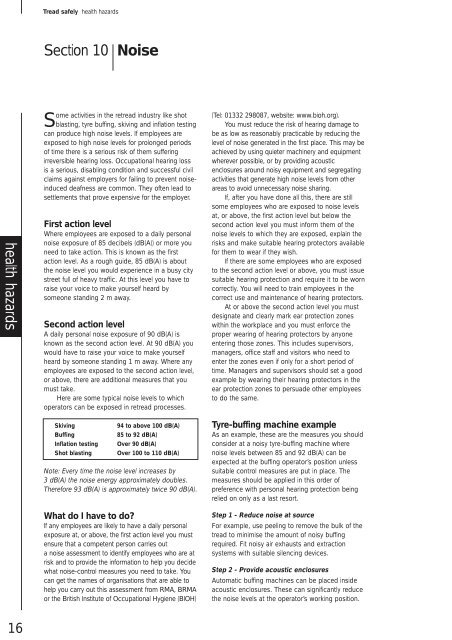INDG380 TREAD SAFELY - HSE
INDG380 TREAD SAFELY - HSE
INDG380 TREAD SAFELY - HSE
You also want an ePaper? Increase the reach of your titles
YUMPU automatically turns print PDFs into web optimized ePapers that Google loves.
health hazards<br />
16<br />
Tread safely health hazards<br />
Section 10 Noise<br />
Some activities in the retread industry like shot<br />
blasting, tyre buffing, skiving and inflation testing<br />
can produce high noise levels. If employees are<br />
exposed to high noise levels for prolonged periods<br />
of time there is a serious risk of them suffering<br />
irreversible hearing loss. Occupational hearing loss<br />
is a serious, disabling condition and successful civil<br />
claims against employers for failing to prevent noiseinduced<br />
deafness are common. They often lead to<br />
settlements that prove expensive for the employer.<br />
First action level<br />
Where employees are exposed to a daily personal<br />
noise exposure of 85 decibels (dB(A)) or more you<br />
need to take action. This is known as the first<br />
action level. As a rough guide, 85 dB(A) is about<br />
the noise level you would experience in a busy city<br />
street full of heavy traffic. At this level you have to<br />
raise your voice to make yourself heard by<br />
someone standing 2 m away.<br />
Second action level<br />
A daily personal noise exposure of 90 dB(A) is<br />
known as the second action level. At 90 dB(A) you<br />
would have to raise your voice to make yourself<br />
heard by someone standing 1 m away. Where any<br />
employees are exposed to the second action level,<br />
or above, there are additional measures that you<br />
must take.<br />
Here are some typical noise levels to which<br />
operators can be exposed in retread processes.<br />
Skiving 94 to above 100 dB(A)<br />
Buffing 85 to 92 dB(A)<br />
Inflation testing Over 90 dB(A)<br />
Shot blasting Over 100 to 110 dB(A)<br />
Note: Every time the noise level increases by<br />
3 dB(A) the noise energy approximately doubles.<br />
Therefore 93 dB(A) is approximately twice 90 dB(A).<br />
What do I have to do?<br />
If any employees are likely to have a daily personal<br />
exposure at, or above, the first action level you must<br />
ensure that a competent person carries out<br />
a noise assessment to identify employees who are at<br />
risk and to provide the information to help you decide<br />
what noise-control measures you need to take. You<br />
can get the names of organisations that are able to<br />
help you carry out this assessment from RMA, BRMA<br />
or the British Institute of Occupational Hygiene (BIOH)<br />
(Tel: 01332 298087, website: www.bioh.org).<br />
You must reduce the risk of hearing damage to<br />
be as low as reasonably practicable by reducing the<br />
level of noise generated in the first place. This may be<br />
achieved by using quieter machinery and equipment<br />
wherever possible, or by providing acoustic<br />
enclosures around noisy equipment and segregating<br />
activities that generate high noise levels from other<br />
areas to avoid unnecessary noise sharing.<br />
If, after you have done all this, there are still<br />
some employees who are exposed to noise levels<br />
at, or above, the first action level but below the<br />
second action level you must inform them of the<br />
noise levels to which they are exposed, explain the<br />
risks and make suitable hearing protectors available<br />
for them to wear if they wish.<br />
If there are some employees who are exposed<br />
to the second action level or above, you must issue<br />
suitable hearing protection and require it to be worn<br />
correctly. You will need to train employees in the<br />
correct use and maintenance of hearing protectors.<br />
At or above the second action level you must<br />
designate and clearly mark ear protection zones<br />
within the workplace and you must enforce the<br />
proper wearing of hearing protectors by anyone<br />
entering those zones. This includes supervisors,<br />
managers, office staff and visitors who need to<br />
enter the zones even if only for a short period of<br />
time. Managers and supervisors should set a good<br />
example by wearing their hearing protectors in the<br />
ear protection zones to persuade other employees<br />
to do the same.<br />
Tyre-buffing machine example<br />
As an example, these are the measures you should<br />
consider at a noisy tyre-buffing machine where<br />
noise levels between 85 and 92 dB(A) can be<br />
expected at the buffing operator’s position unless<br />
suitable control measures are put in place. The<br />
measures should be applied in this order of<br />
preference with personal hearing protection being<br />
relied on only as a last resort.<br />
Step 1 - Reduce noise at source<br />
For example, use peeling to remove the bulk of the<br />
tread to minimise the amount of noisy buffing<br />
required. Fit noisy air exhausts and extraction<br />
systems with suitable silencing devices.<br />
Step 2 - Provide acoustic enclosures<br />
Automatic buffing machines can be placed inside<br />
acoustic enclosures. These can significantly reduce<br />
the noise levels at the operator’s working position.

















